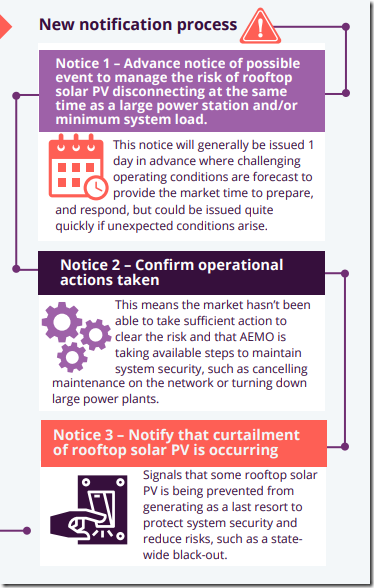Today’s newest low point for minimum demand in South Australia was just the latest in a growing (and accelerating!) number of milestones being reached in the ‘race to the bottom’. Each time the bottom drops lower still reminds us of the reasons behind Daniel Westerman’s BHAG announced just over two months ago!
Timely, then, that on Friday (24th September) the AEMO announced this “new market signal to improve transparency and system security”…. which goes on to say:
“The Australian Energy Market Operator (AEMO) is introducing a new market notification framework to increase transparency on actions taken to maintain power system security during challenging system operating conditions coupled with high rooftop solar photovoltaic (PV) exports.
In continuing to support increasing levels of rooftop solar PV, AEMO’s new protocol foreshadows challenging operational conditions, seeks a market-based response, and communicates actions needed to maintain system security.
AEMO Chief Operations Officer, Michael Gatt, said the market notification framework responds to stakeholder feedback for improved transparency and supports longer-term industry solutions to better utilise rooftop solar PV and flexible load.”
(A) The new notice arrangement
AEMO’s new notifications consists of three sequential notices – about Distributed Photovoltaics (DPV) Contingency and / or Minimum System Load :
Step 1 = Forecast potential Contingency or Minimum System Load event and seeking a market response.
Step 2 = Advise action has been taken to maintain system security.
Step 3 = Notify that curtailment of rooftop solar PV is occurring as a last resort because preceding actions have not been sufficient to maintain power system security.
This was laid out in this helpful Factsheet about ’Operating the grid with high roof-top solar generation’, from which I have extracted this illustration:
(B) Similarities already in use … with LRC/LOR Notices
AEMO uses a similar process to notify the market of forecast low electricity reserves, known as Lack of Reserve (LOR) … or Low Reserve Condition (LRC) notices.
Those notices encourage generators to bid into the market or businesses to reduce usage and inform the market of the activation of the Reliability and Emergency Reserve Trader mechanism (i.e. RERT) to avoid load shedding.
(C) Coverage on WattClarity
There have already been plenty of articles written here about ‘minimum demand’ … so we’ll wait to see how soon it will be that we post any new articles about this new Market Notice Framework about ‘Minimum System Load’ and/or ‘Distributed Photovoltaics (DPV) Contingency’!



Leave a comment